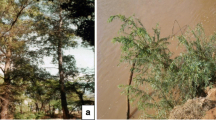Abstract
AFLP markers were used to assess genetic relationships among Cicer species with distribution in Turkey. Genetic distances were computed among 47 Cicer accessions representing four perennial and six annual species including chickpea, using 306 positions on AFLP gels. AFLP-based grouping of species revealed two clusters, one of which includes three perennial species, Cicer montbretii, Cicer isauricum and Cicer anatolicum, while the other cluster consists of two subclusters, one including one perennial, Cicer incisum, along with three annuals from the second crossability group (Cicer pinnatifidum, Cicer judaicum and Cicer bijugum) and the other one comprising three annuals from the first crossability group (Cicer echinospermum, Cicer reticulatum and Cicer arietinum). Consistent with previous relationship studies in the same accession set using allozyme and RAPD markers, in AFLP-based relationships, C. incisum was the closest perennial to nearly all annuals, and C. reticulatum was the closest wild species to C. arietinum. Cluster analysis revealed the grouping of all accessions into their distinct species-clusters except for C. reticulatum accessions, ILWC247, ILWC242 and TR54961; the former was found to be closer to the C. arietinum accessions while the latter two clustered with the C. echinospermum group. Small genetic distance values were detected among C. reticulatum accessions (0.282) and between C. reticulatum and C. arietinum (0.301) indicating a close genetic similarity between these two species. Overall, the AFLP-based genetic relationships among accessions and species were congruous with our previous study of genetic relationships using allozymes. The computed level of AFLP variation and its distribution into within and between Cicer species paralleled the previous report based on RAPD analyses. AFLP analysis also confirmed the presence of the closest wild relatives and previous projections of the origin of chickpea in southern Turkey. Results presented in this report indicate that AFLP analysis is an efficient and reliable marker technology in determination of genetic variation and relationships in the genus Cicer. Obviously, the use of AFLP fingerprinting in constructing a detailed genetic map of chickpea and cloning, and characterizing economically important traits would be promising as well.


Similar content being viewed by others
References
Ahmad F (1999) Random amplified polymorphic DNA (RAPD) analysis reveals genetic relationships among the annual Cicer species. Theor Appl Genet 98:657–663
Ahmad F, Slinkard AE (1992) Genetic relationships in the genus Cicer L. as revealed by polyacrylamide gel electrophoresis of seed storage proteins. Theor Appl Genet 84:688–692
Ahmad F, Gaur PM, Slinkard AE (1992) Isozyme polymorphism and phylogenetic interpretations in the genus Cicer L. Theor Appl Genet 83:620–627
Bassam BJ, Caetano-Anollés G, Gresshoff PM (1991) Fast and sensitive silver staining DNA in polyacrylamide gels. Anal Biochem 196:80–83
Botstein D, White RL, Skolnick MH, Davis RW (1980) Construction of a genetic map in man using restriction fragment length polymorphisms Am J Hum Genet 32:314–331
Caetano-Anollés G, Bassam BJ, Gresshoff PM (1991) DNA amplification fingerprinting: a strategy for genome analysis. Plant Mol Biol Rep 9:292–305
Davis PH(1973) The flora of Turkey. Edinburgh University Press, Edinburgh, Scotland, vol. 3, pp 267–273
Eujayl I, Baum M, Powell W, Erskine W, Pehu E (1998) A genetic linkage map of (Lens sp.) based on RAPD and AFLP markers using recombinant inbred lines. Theor Appl Genet 97:83–89
Heun M, Schäfer-Pregl R, Klawan D, Castagna R, Accerbi M, Borghi B, Salamini F (1997) Site of einkorn wheat domestication identified by DNA fingerprinting. Science 275:1312–1314
Hill M, Witsenboer H, Zabeau M, Vos P, Kesseli R, Michelmore R (1996) PCR-based fingerprinting using AFLPs as a tool for studying genetic relationships in Lactuca spp. Theor Appl Genet 93:1202–1210
Hongtrakul V, Huestis GM, Knapp SJ (1997) Amplified fragment length polymorphisms as a tool for DNA fingerprinting sunflower germplasm: genetic diversity among oilseed inbred lines. Theor Appl Genet 95:400–407
Iruela M, Rubio J, Cubero JI, Gil J, Millán T (2002) Phylogenetic analysis in the genus Cicer and cultivated chickpea using RAPD and ISSR markers. Theor Appl Genet 104:643–651
Karp A, Kresovich S, Bahat KV, Ayad WG, Hodgkin T (1997) Molecular tools in plant genetic resources conservation; a guide to the technologies. IPTG Technical Bulletin No. 2. International Plant genetic Resources Institute, Rome, Italy
Kazan K, Muehlbauer FJ (1991) Allozyme variation and phylogeny in annual species of Cicer (Leguminosae). Plant Syst Evol 175:11–21
Kazan K, Muehlbauer FJ, Weeden NF, Ladizinsky G (1993) Inheritance and linkage relationships of morphological and isozyme loci in chickpea (Cicer arietinum L.). Theor Appl Genet 86:417–426
Kumar LS (1999) DNA markers in plant improvement: an overview. Biotechnol Adv 17:143–182
Kovach WL (2000) Multi-variate statistical package (MVSP). Ver. 3.1h; Kovach Computing Services, Wales, UK, http://www.kovcomp.com
Labdi M, Robertson LD, Singh KB, Charrier A (1996) Genetic diversity and phylogenetic relationships among the annual Cicer species as revealed by isozyme polymorphisms. Euphytica 88:181–188
Ladizinsky G, Adler A (1976) Genetic relationships among the annual species of Cicer L. Theor Appl Genet 48:197–203
Lu J, Knox MR, Ambrose MJ, Brown JKM, Ellis THN (1996) Comparative analysis of genetic diversity in pea assessed by RFLP- and PCR-based methods. Theor Appl Genet 93:1103–1111
Masiga DK, Tait A, Turner CMR (2000) Amplified restriction fragment length polymorphism in parasite genetics. Parasitol Today 16:350–353
Mueller UG, Wolfenbarger LL (1999) AFLP genotyping and fingerprinting. TREE 14:389–394
Nei M, Li WH (1979) Mathematical model for studying genetic variation in terms of restriction endonucleases. Proc Natl Acad Sci USA 76:5269–5273
Nybom H, Bartish IV (2000) Effects of life history traits and sampling strategies on genetic diversity estimates obtained with RAPD marker in plants. Perspectives in Plant Ecology, Evolution and Systematics 3/2, pp 93–114
Pejic I, Ajmone-Marsan P, Morgante M, Kozumplik V, Castiglioni P, Taramino G, Motto M (1998) Comparative analysis of genetic similarity among maize inbred lines detected by RFLPs, RAPDs, SSRs and AFLPs. Theor Appl Genet 97:1248–1255
Sharma SK, Knox MR, Ellis THN (1996) AFLP analysis of the diversity and phylogeny of Lens and its comparison with RAPD analysis. Theor Appl Genet 93:751–758
Sharma PC, Winter P, Bunger T, Huttel B, Weigand F, Weising K, Kahl G (1995) Abundance and polymorphism of di-, tri- and tetra-nucleotide tandem repeats in chickpea (Cicer arietinum L.). Theor Appl Genet 90:90–96
Simon CJ, Muehlbauer FJ (1997) Construction of a chickpea linkage map and its comparison with map of pea and lentil. J Hered 88: 115–119
Singh KB (1997) Chickpea (Cicer arietinum L.). Field Crop Res 53:161–170
Sudupak MA, Kence A (2002) Genetic relationships among perennial and annual Cicer species growing in Turkey as revealed by allozymes. Genetic Res Crop Evol (in press)
Sudupak MA, Akkaya MS, Kence A (2002) Analysis of genetic relationships among perennial and annual Cicer species growing in Turkey using RAPD markers. Theor Appl Genet 105:1220–1228
Tayyar RI, Waines JG (1996) Genetic relationships among annual species of Cicer (Fabaceae) using isozyme variation. Theor Appl Genet 92:245–254
Udupa SM, Roberson LD, Weigand F, Baum M, Kahl G (1999) Allelic variation at (TAA-II) microsatellite loci in a world collection of chickpea (C. arietinum L.) germplasm. Mol Gen Genet 261:354–363
Van der Maesen LJG (1987) Origin, history and taxonomy of chickpea. In: Saxena MC, Singh KB (eds) The chickpea. CAB International Publication, UK, pp 11–34
Vos P, Hogers R, Bleeker M, Reijans M, Van de Lee T. Hornes M, Frijters A, Potet J, Pelemen J, Kuiper M, Zebeau M (1995) AFLP: a new technique for DNA fingerprinting. Nucleic Acids Res 23:4407–4414
Weising K, Kaemmer D, Weigand F, Epplen JT, Kahl G (1992) Oligonucleotide fingerprinting reveals various probe-dependent levels of informativeness in chickpea (Cicer arietinum L.). Genome 35:436–442
Welsh J, McClelland M (1991) Fingerprinting genomes using PCR with arbitrary primers. Nucleic Acids Res 18:7213–7218
Westman AL, Kresovich S (1997) Use of molecular marker techniques for description of plant genetic variation. In: Callow JA, Ford-Lloyd BV, Newbury HJ (eds) Biotechnology and plant genetic resources, CAB International. pp 9–48
Williams JGK, Kubelik AR, Livak KJ, Rafalski JA, Tingeyl SV (1990) DNA polymorphisms amplified by arbitrary primers are useful genetic markers. Nucleic Acids Res 18:6531–6535
Winter P, Pfaff T, Udupa SM, Hüttel B, Sharma PC, Sahi S, Arreguin-Espinoza R, Weigand F, Muehlbauer FJ, Kahl G (1999) Characterization and mapping of sequence-tagged microsatellite sites in the chickpea (Cicer arietinum L.) genome. Mol Gen Genet 262:90–101
Yeh FC, Yang RC, Boyle TJB, Ye ZH, Mao JX (1997) POPGENE, the user-friendly shareware for population genetic analysis. Ver. 1.32. Molecular Biology and Biochemistry Center, University of Alberta, Canada
Zabeau M, Vos P (1993) Selective restriction fragment amplification: a general method for DNA fingerprinting. European patent application, EP 0534858
Acknowledgements
The authors thank Dr. Fred. J. Muehlbauer for reviewing the manuscript and providing valuable suggestions. The authors also acknowledge the support of the project, 2000-K120 180-2002, by The Republic of Turkey, The State Planning Organization. Thanks were also extended to the authorities at ICARDA, Aleppo, Syria, the Aegean Agricultural Research Institute, Menemen, İzmir, Turkey and the Anatolian Agricultural Research Institute, Eskişehir, Turkey, for providing seed material to conduct this study.
Author information
Authors and Affiliations
Corresponding author
Additional information
Communicated by P. Langridge
Rights and permissions
About this article
Cite this article
Sudupak, M.A., Akkaya, M.S. & Kence, A. Genetic relationships among perennial and annual Cicer species growing in Turkey assessed by AFLP fingerprinting. Theor Appl Genet 108, 937–944 (2004). https://doi.org/10.1007/s00122-003-1505-8
Received:
Accepted:
Published:
Issue Date:
DOI: https://doi.org/10.1007/s00122-003-1505-8




